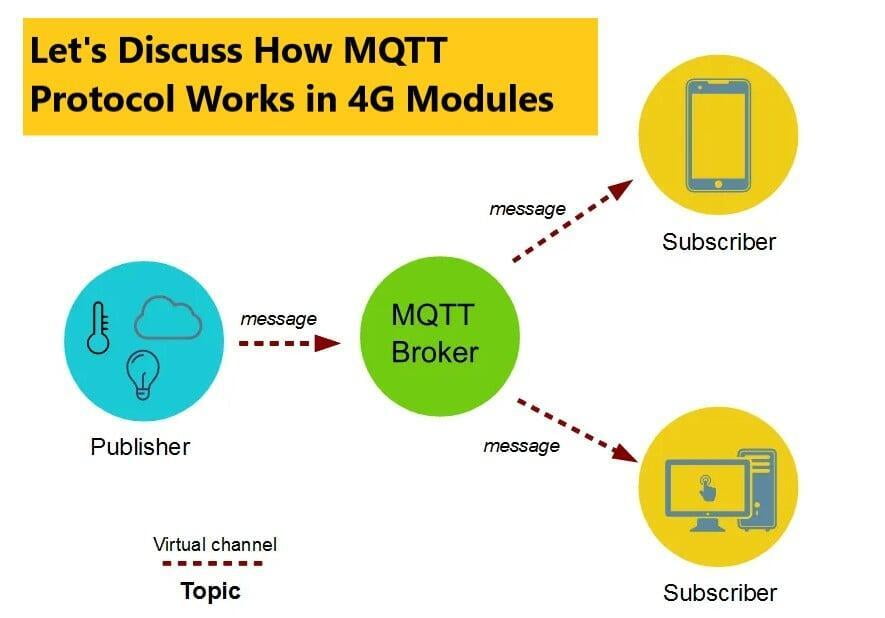
In the ever-evolving landscape of communication technologies, the integration of MQTT (Message Queuing Telemetry Transport) protocol with 4G modules has become an important aspect in IOT. In this article we will discuss how the MQTT protocol works in 4G modules, we will understand what MQTT protocol is, its use cases. And much more.
What is MQTT?
MQTT is a standards-based messaging protocol, or set of rules, used for machine-to-machine communication. Smart sensors, wearables, and other Internet of Things (IoT) devices typically have to transmit and receive data over a resource-constrained network with limited bandwidth. These IoT devices use MQTT for data transmission, as it is easy to implement and can communicate IoT data efficiently. MQTT supports messaging between devices to the cloud and the cloud to the device.
The MQTT Protocol Consists of Four Main Components
Client: A device or application that connects to the MQTT broker to either publish or subscribe to topics.
Broker: A server that receives and distributes messages between publishers and subscribers. The broker is responsible for authenticating clients, enforcing access control, and managing subscriptions and message delivery.
Topics: A named channel that a publisher uses to send messages to subscribers. Topics are hierarchical and use a forward-slash (/) as a delimiter to create a tree-like structure.
QoS (Quality of Service): MQTT provides three levels of QoS to ensure message delivery reliability. QoS 0 delivers messages at most once, QoS 1 delivers messages at least once, and QoS 2 delivers messages exactly once.
The basic flow of MQTT communication is as follows:
The client connects to the broker using a TCP/IP connection and authenticates itself.
The client subscribes to one or more topics by sending a SUBSCRIBE message to the broker.
The publisher sends a message to the broker, which stores the message and forwards it to all subscribers that have subscribed to the corresponding topic.
The broker sends the message to the subscribers based on their QoS level.
The subscribers receive the message and acknowledge receipt to the broker based on their QoS level.
The publisher and subscribers can disconnect from the broker by sending a DISCONNECT message.
Why is the MQTT protocol significant?
The MQTT protocol has attained the status of a standard in IoT data transmission because of the following advantages:
Lightweight and Efficient Implementing:
MQTT on IoT devices demands minimal resources, making it suitable for deployment even on small microcontrollers. A case in point is a basic MQTT control message that can consist of as little as two data bytes. Additionally, MQTT message headers are designed to be compact, enabling optimization of network bandwidth.
Scalable:
The implementation of MQTT involves a modest amount of code that consumes minimal power during operations. The protocol is equipped with inherent features that facilitate communication with a vast number of IoT devices. Consequently, deploying the MQTT protocol allows seamless connection with millions of such devices.
Reliable:
Numerous IoT devices operate in environments characterized by unreliable cellular networks with low bandwidth and high latency. MQTT incorporates features that mitigate the time taken by IoT devices to reconnect with the cloud. Moreover, it defines three distinct quality-of-service levels— at most once (0), at least once (1), and exactly once (2)—to ensure reliability in various IoT use cases.
Secure:
MQTT streamlines the process for developers to encrypt messages and authenticate devices and users, leveraging contemporary authentication protocols like OAuth, TLS1.3, Customer Managed Certificates, and more.
Well-supported:
Languages such as Python offer robust support for the implementation of the MQTT protocol, enabling developers to swiftly incorporate it into diverse applications with minimal coding effort.
How to Establish MQTT Connection with SIM7672 4G Module
SIM7672 MQTT AT Commands
The SIM7672 GSM Modem comes with a pre-installed MQTT AT commands stack. These AT commands help us to establish connections with an MQTT broker and publish messages. Additionally, we can subscribe to MQTT topics, facilitating the reception of messages from other MQTT clients. Refer to the table below, which illustrates the utilization of diverse AT commands related to MQTT.
Command | Function | Example |
AT+CMQTTSTART | Open network |
|
AT_CMQTTSTOP | Close network |
|
AT+CMQTTACCQ | Initialise MQTT client | AT+CMQTTACCQ=0,"elementz123” |
AT+CMQTTREL | Destroy MQTT client |
|
AT+CMQTTCONNECT | Connect to Server | AT+CMQTTCONNECT=0,"tcp://test.mosquitto.org:1883",90,1 |
AT+CMQTTDISC | Disconnect from server |
|
AT+CMQTTTOPIC | Set topic for publishing | AT+CMQTTTOPIC=0,8 |
AT+CMQTTPAYLOAD | Set payload for publishing | AT+CMQTTPAYLOAD=0,1 |
AT+CMQTTPUB | Publish the topic and payload set with CMQTTTOPIC and CMQTTPAYLOAD | AT+CMQTTPUB=0,1,60 |
AT+CMQTTSUBTOPIC | Set topic for subscription | AT+CMQTTSUBTOPIC=0,9,1 |
AT+CMQTTSUB | Subscribe the topic set in CMQTTSUBTOPIC | AT+CMQTTSUB=0,4,1,1 |
AT+CMQTTUNSUBTOPIC | Set topic for unsubscribe |
|
AT+CMQTTUNSUB | Unsubscribe the MQTT topic set by CMQTTUNSUB |
|
You can use microcontroller for eg. ESP32, Arduino or which has UART pins to connect with SIM7672 4G module, to fully automate the AT sequence and run the system seamlessly.
You can refer below image for interfacing microcontroller with SIM7672 module:
Applications of MQTT Integrated with 4G Modules
Smart Cities
In the realm of smart cities, MQTT over 4G enables efficient communication between various sensors, devices, and infrastructure components.
Industrial IoT
In industries, the combination facilitates real-time monitoring and control, ensuring seamless operations and quick response to potential issues.
Home Automation
In smart homes, MQTT over 4G allows devices to communicate seamlessly, providing homeowners with centralized control over various appliances and systems.
Conclusion
MQTT's simplicity and efficiency make it an ideal choice for many IoT and M2M communication scenarios, where low power consumption, small code footprint, and low network bandwidth are essential.
If you want to establish MQTT communication Protocol in your project then SIM7672 4G module is the best in overall performance. If you're ready to elevate your projects with the seamless synergy of MQTT and SIM7672, and many other electronic components, visit the best electronic components online store- Campus Component today.

